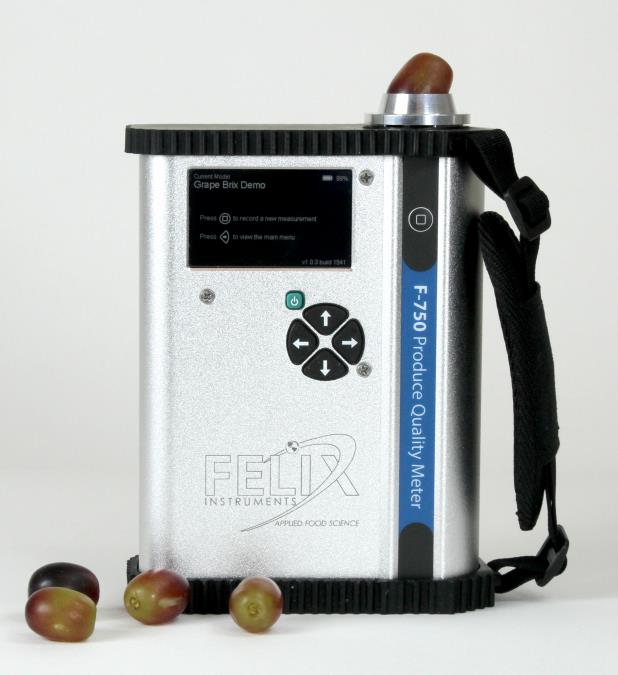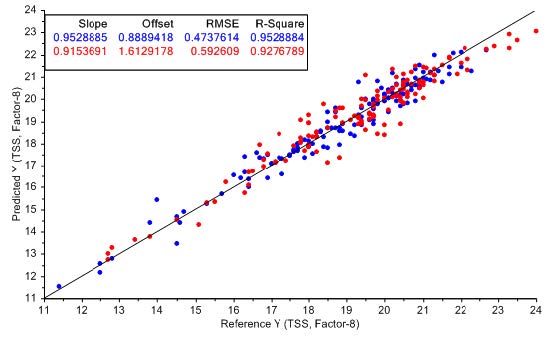October 31, 2016 at 8:20 pm | Updated October 31, 2016 at 8:20 pm | 3 min read
Non-destructive measurements of internal quality indicators for SEEDLESS GRAPES, VITIS VINIFERA
Sugar content is an important metric in determining proper harvest time in grapes and eating quality. The ability to quickly and accurately measure the internal properties of a fruit helps save time and money, especially when these methods are non-destructive. To determine effectiveness and viability of the F-750 Produce Quality Meter in measuring internal sugar content, a study was carried out sampling 270 seedless grapes. A refractometer was used to collect reference values of total soluble solids, a representative value for ºBrix. Measured values were correlated with the spectral data, and results show that the F-750 Produce Quality Meter precisely and non-destructively measures total soluble solids, with a calculated root mean square error of validation of 0.59 TSS. Similar results are expected for other grape and small fruit varieties, as well as the ability of the F-750 to measure other metrics such as dry matter and acidity.
Materials and Methods:
Subscribe to the Felix instruments Weekly article series.
By submitting this form, you are consenting to receive marketing emails from: . You can revoke your consent to receive emails at any time by using the SafeUnsubscribe® link, found at the bottom of every email. Emails are serviced by Constant Contact
In April 2015, 270 red and green seedless grapes were measured using an F-750 Produce Quality Meter. A small fruit eyepiece was used to maximize refraction by optimizing the side wall angle and focusing light onto the sample. The eyepiece helps standardize sample presentation, and eliminate light leakage. Next, the same grapes measured with the F-750 were destructively measured for total soluble solids (TSS) using a refractometer. These reference values were compared to the spectral data collected with the instrument using the Model Builder program included with the F-750, and analyzed for correlations between the spectral signal and TSS using a spectral range of 729-975 nm. Half of the collected grape data were separated and used for independent validation combining both grape varieties. The resulting data were analyzed for linearity, root mean squared error, and cross validation error to determine the applicability and accuracy of the created model.

Figure 1. F-750 fitted with small fruit eyepiece.
Results and Discussion:
Results show that the F-750 Produce Quality Meter precisely and non-destructively measures the internal properties of grapes. A strong correlation between spectral data and collected reference values is illustrated by a model prediction R2 of 0.95. Figure 2 displays this correlation and demonstrates the consistency of measurement. A calculated root mean square error of validation (RMSEV) of 0.59 further illustrates the accuracy of the created model. This RMSEV value indicates the amount of error the model displayed for a given measurement when the model was loaded onto the F-750 and used to predict TSS. Both red and green grape berries were used in this study, and no differences in performance were detected between the two varieties for the spectral range selected.

Figure 2. Prediction error for red and green seedless grapes using the F-750. Specimen most strongly correlated to the calculated trend line show the greatest accuracy of prediction (Red: Independent validation, Blue: Training set prediction).
Conclusions:
The F-750 performed well and predicted accurately using both red and green seedless grapes and the small fruit eyepiece. Other research findings (See Further Reading and Supporting Science section below) and a clear correlation with TSS strongly suggests the ability to measure other important internal fruit metrics such as dry matter and acidity with the F-750. We expect similar results with other varieties of grape berry including seeded and white grapes.
Further Reading and Supporting Science:
Cozzolino, D. et al. (2006) Chemometrics and visible-near infrared spectroscopic monitoring of red wine fermentation in a pilot scale. Biotechnol. Bioeng, 95: 1101-1107.
Herrera, J., A Guesalaga, and E. Agosin (2003) Shortwave-near infrared spectroscopy for non-destructive determination of maturity of wine grapes. Meas. Sci. Technol. 14:689.
Pirie, A. and M.G. Mullins (1977) Interrelationships of sugars, anthocyanins, total phenols and dry weight in the skin of grape berries during ripening. American journal of enology and viticulture, 4: 204-209.
Related Products
- F-751 Grape Quality Meter
- Custom Model Building
- F-901 AccuRipe & AccuStore
- F-751 Melon Quality Meter
- F-751 Kiwifruit Quality Meter
- F-750 Produce Quality Meter
- F-751 Avocado Quality Meter
- F-751 Mango Quality Meter
- F-900 Portable Ethylene Analyzer
- F-950 Three Gas Analyzer
- F-920 Check It! Gas Analyzer
- F-960 Ripen It! Gas Analyzer
- F-940 Store It! Gas Analyzer
Most Popular Articles
- Spectrophotometry in 2023
- The Importance of Food Quality Testing
- NIR Applications in Agriculture – Everything…
- The 5 Most Important Parameters in Produce Quality Control
- Melon Fruit: Quality, Production & Physiology
- Guide to Fresh Fruit Quality Control
- Liquid Spectrophotometry & Food Industry Applications
- Ethylene (C2H4) – Ripening, Crops & Agriculture
- Fruit Respiration Impact on Fruit Quality
- Active Packaging: What it is and why it’s important


